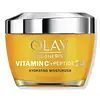What's inside
What's inside
 Key Ingredients
Key Ingredients

 Benefits
Benefits

 Concerns
Concerns

 Ingredients Side-by-side
Ingredients Side-by-side

Water
Skin ConditioningSimmondsia Chinensis Seed Oil
EmollientPolysorbate 80
EmulsifyingGlycerin
HumectantCarthamus Tinctorius Seed Oil
MaskingSodium Hyaluronate
HumectantButylene Glycol
HumectantCamellia Sinensis Leaf Extract
AntimicrobialCitric Acid
BufferingRetinyl Palmitate
Skin ConditioningPropylene Glycol
HumectantPolysorbate 20
EmulsifyingCarbomer
Emulsion StabilisingTripeptide-1
Skin ConditioningPhenoxyethanol
PreservativeEthylhexylglycerin
Skin ConditioningHexapeptide-9
Skin ConditioningAcetyl Hexapeptide-7
Skin ProtectingAcetyl Hexapeptide-1
Skin ConditioningAluminum Acetate Solution
AstringentHexapeptide-35
Skin ConditioningTocopherol
AntioxidantAscorbic Acid
AntioxidantCollagen
MoisturisingPalmitoyl Pentapeptide-4
Skin ConditioningPalmitoyl Tetrapeptide-7
Skin ConditioningPalmitoyl Tripeptide-5
Skin ConditioningAluminum Diacetate
Antimicrobial1,2-Hexanediol
Skin ConditioningHexapeptide-2
BleachingAcetyl Hexapeptide-8
HumectantCopper Tripeptide-1
Skin ConditioningPalmitoyl Tripeptide-1
Skin ConditioningAcetyl Tetrapeptide-5
HumectantWater, Simmondsia Chinensis Seed Oil, Polysorbate 80, Glycerin, Carthamus Tinctorius Seed Oil, Sodium Hyaluronate, Butylene Glycol, Camellia Sinensis Leaf Extract, Citric Acid, Retinyl Palmitate, Propylene Glycol, Polysorbate 20, Carbomer, Tripeptide-1, Phenoxyethanol, Ethylhexylglycerin, Hexapeptide-9, Acetyl Hexapeptide-7, Acetyl Hexapeptide-1, Aluminum Acetate Solution, Hexapeptide-35, Tocopherol, Ascorbic Acid, Collagen, Palmitoyl Pentapeptide-4, Palmitoyl Tetrapeptide-7, Palmitoyl Tripeptide-5, Aluminum Diacetate, 1,2-Hexanediol, Hexapeptide-2, Acetyl Hexapeptide-8, Copper Tripeptide-1, Palmitoyl Tripeptide-1, Acetyl Tetrapeptide-5
Water
Skin ConditioningGlycerin
HumectantIsohexadecane
EmollientNiacinamide
SmoothingDimethicone
EmollientLactic Acid
BufferingIsopropyl Isostearate
EmollientSodium Polyacryloyldimethyl Taurate
Emulsion StabilisingStearyl Alcohol
Emollient3-O-Ethyl Ascorbic Acid
Skin ConditioningPalmitoyl Pentapeptide-4
Skin ConditioningPanthenol
Skin ConditioningSodium Lactate
BufferingTrehalose
HumectantCetearyl Glucoside
EmulsifyingCetearyl Alcohol
EmollientBehenyl Alcohol
EmollientCetyl Alcohol
EmollientStearic Acid
CleansingPalmitic Acid
EmollientDimethiconol
EmollientPEG-100 Stearate
Sodium Benzoate
MaskingParfum
MaskingAscorbic Acid
AntioxidantAvena Sativa Peptide
Skin ConditioningWater, Glycerin, Isohexadecane, Niacinamide, Dimethicone, Lactic Acid, Isopropyl Isostearate, Sodium Polyacryloyldimethyl Taurate, Stearyl Alcohol, 3-O-Ethyl Ascorbic Acid, Palmitoyl Pentapeptide-4, Panthenol, Sodium Lactate, Trehalose, Cetearyl Glucoside, Cetearyl Alcohol, Behenyl Alcohol, Cetyl Alcohol, Stearic Acid, Palmitic Acid, Dimethiconol, PEG-100 Stearate, Sodium Benzoate, Parfum, Ascorbic Acid, Avena Sativa Peptide
 Reviews
Reviews

Ingredients Explained
These ingredients are found in both products.
Ingredients higher up in an ingredient list are typically present in a larger amount.
Ascorbic Acid is is pure Vitamin C. This form makes up the largest amount of vitamin C found naturally in our skin.
Not only is vitamin C great for your overall health and immune system, it also has plenty of benefits on your skin.
Vitamin C is best used for brightening skin. It improves dark spots, acne scars, and hyperpigmentation. This is because it blocks the process of skin darkening when exposed to UV.
Remember: Vitamin C should not replace sunscreen!
Your skin uses vitamin C to build collagen. Collagen is one key component in having a strong skin barrier and plump skin. Vitamin C also plays a role in regulating collagen, thus making it effective in improving wrinkles and fine lines.
Ascorbic acid shows potent antioxidant activity. As an antioxidant, it helps fight free-radicals. Free-radicals are molecules that may damage your skin cells. These antioxidants also protect skin against UV damage.
The best formulations include Vitamin E and/or ferulic acid. These two ingredients help stabilize and provide a boost in the benefits of ascorbic acid. This is because ascorbic acid becomes unstable when exposed to UV and air. In fact, you can tell your ascorbic acid has oxidized when it turns an orange-yellow color.
Ascorbic acid is generally compatible with other ingredients. However, using ascorbic acid with other active ingredients might cause irritation. Two ingredients: copper ions and benzoyl peroxide, will inactivate ascorbic acid completely.
Read more about other types of Vitamin C:
Foods rich with vitamin C include oranges, strawberries, broccoli, bell peppers, and more. When consuming Vitamin C, your skin receives a portion of the nutrients.
Learn more about Ascorbic AcidGlycerin is already naturally found in your skin. It helps moisturize and protect your skin.
A study from 2016 found glycerin to be more effective as a humectant than AHAs and hyaluronic acid.
As a humectant, it helps the skin stay hydrated by pulling moisture to your skin. The low molecular weight of glycerin allows it to pull moisture into the deeper layers of your skin.
Hydrated skin improves your skin barrier; Your skin barrier helps protect against irritants and bacteria.
Glycerin has also been found to have antimicrobial and antiviral properties. Due to these properties, glycerin is often used in wound and burn treatments.
In cosmetics, glycerin is usually derived from plants such as soybean or palm. However, it can also be sourced from animals, such as tallow or animal fat.
This ingredient is organic, colorless, odorless, and non-toxic.
Glycerin is the name for this ingredient in American English. British English uses Glycerol/Glycerine.
Learn more about GlycerinYou might know this ingredients as Matrixyl, a famous peptide.
Peptides are building blocks for protein. Palmitoyl Pentapeptide-4 consists of five amino acids. These amino acids include: 2 lysines, 2 threonines, and serine
This ingredients tells our body to create more collagen. Collagen is a protein that makes connective tissue. Boosting collagen production leads to a healthier skin barrier. Having a healthy skin barrier means having firm and hydrated skin.
Thus, Matrixyl may help improve the look of wrinkles.
Read more about other common types of peptides here:
Learn more about Palmitoyl Pentapeptide-4Water. It's the most common cosmetic ingredient of all. You'll usually see it at the top of ingredient lists, meaning that it makes up the largest part of the product.
So why is it so popular? Water most often acts as a solvent - this means that it helps dissolve other ingredients into the formulation.
You'll also recognize water as that liquid we all need to stay alive. If you see this, drink a glass of water. Stay hydrated!
Learn more about Water